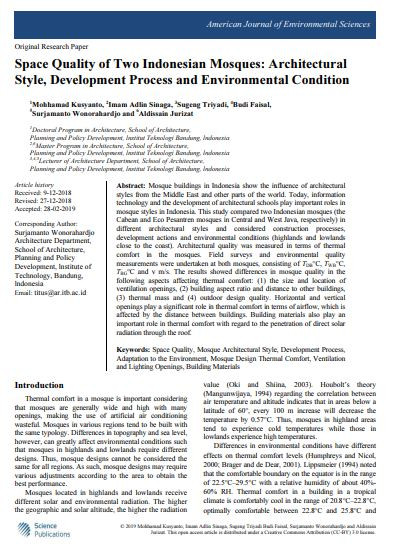
Mosque buildings in Indonesia show the influence of architectural styles from the Middle East and other parts of the world. Today, information technology and the development of architectural schools play important roles in mosque styles in Indonesia. This study compared two Indonesian mosques (the Cabean and Eco Pesantren mosques in Central and West Java, respectively) in different architectural styles and considered construction processes, development actions and environmental conditions (highlands and lowlands close to the coast). Architectural quality was measured in terms of thermal comfort in the mosques. Field surveys and environmental quality measurements were undertaken at both mosques, consisting of TDB°C, TWB°C, TBG°C and v m/s. The results showed differences in mosque quality in the following aspects affecting thermal comfort: (1) the size and location of ventilation openings, (2) building aspect ratio and distance to other buildings, (3) thermal mass and (4) outdoor design quality. Horizontal and vertical openings play a significant role in thermal comfort in terms of airflow, which is affected by the distance between buildings. Building materials also play an important role in thermal comfort with regard to the penetration of direct solar radiation through the roof.
I agree to the terms outlined below:
You agree to upload and assign Mosqpedia Database the rights to use the content worldwide and in perpetuity across all current and future media platforms. Mosqpedia Database may edit, copy, adapt and translate your contribution.
The content will be distributed under the Creative Commons Attribution-Deed – Attribution-NonCommercial-NoDerivatives 4.0 International – Creative Commons
All data will be stored in line with data protection regulations.